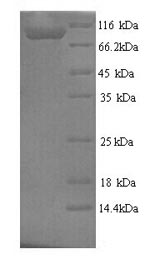Recombinant Rat Microtubule-associated protein tau (Mapt) gets expressed in yeast and includes the full-length mature protein spanning amino acids 2 to 752. The product comes with an N-terminal 6xHis-tag, which makes purification and detection more straightforward. SDS-PAGE analysis indicates the protein reaches high purity levels—over 90%—suggesting it should work well for research applications that demand precise protein interactions and analysis.
Microtubule-associated protein tau (Mapt) appears to play a critical role in keeping microtubules stable. These structures form essential parts of the cellular cytoskeleton. Tau proteins seem crucial for maintaining neuronal architecture and helping with axonal transport. They're involved in cellular processes tied to microtubule assembly and stabilization, which likely makes them important for neurobiological research and studies examining neurodegenerative diseases.
Potential Applications
Note: The applications listed below are based on what we know about this protein's biological functions, published research, and experience from experts in the field. However, we haven't fully tested all of these applications ourselves yet. We'd recommend running some preliminary tests first to make sure they work for your specific research goals.
Based on the provided information, recombinant rat tau protein (MAPT) is produced in a yeast expression system as a full-length mature protein (2-752aa) with an N-terminal 6xHis-tag. Tau is an intrinsically disordered protein that does not require a fixed tertiary structure for its microtubule-binding function, which reduces folding concerns compared to globular proteins. However, proper biological activity still depends on maintaining specific domain interactions and post-translational modification patterns. Yeast expression systems provide eukaryotic chaperones but may not replicate the phosphorylation patterns critical for tau regulation. The N-terminal His-tag may interfere with tau's N-terminal projection domain function. No validation data (e.g., microtubule binding assays, circular dichroism) are provided. Therefore, while the protein has a reasonable probability of being functional, its bioactivity cannot be confirmed without experimental validation.
1. In Vitro Microtubule Binding and Stabilization Assays
Tau's microtubule binding depends on its C-terminal repeats, but the N-terminal domain regulates spacing; the tag may disrupt this balance. If the recombinant tau maintains its intrinsically disordered structure and functional domains, it could be used for microtubule binding studies. However, the N-terminal His-tag may sterically interfere with the projection domain's function, potentially affecting binding kinetics or microtubule stabilization efficiency. If the protein is improperly modified or aggregated, binding assays would yield inaccurate results.
2. Protein-Protein Interaction Studies
Tau interacts with numerous partners; tag position and expression system may alter interaction profiles. If properly expressed, the His-tagged tau could identify interaction partners, but yeast may lack mammalian-specific tau modifiers. The tag might cause false positives in pull-down assays or mask genuine interactions involving the N-terminal domain. Always validate interactions with endogenous tau.
3. Antibody Development and Validation
Tau antibodies often target phosphorylation sites; yeast expression may not replicate mammalian PTMs. This application is suitable as tau's linear epitopes are well-conserved. The full-length protein provides comprehensive coverage for antibody generation. However, antibodies may not recognize phosphorylation-dependent epitopes if yeast lacks appropriate kinases.
4. Biochemical Characterization and Post-Translational Modification Studies
Tau's function is heavily modification-dependent; the baseline state must be characterized. The recombinant tau can serve as a substrate for in vitro modification studies, but baseline phosphorylation from yeast may differ from mammalian tau. Use specific kinases/phosphatases to establish physiological modification patterns before functional studies.
5. Structural and Biophysical Analysis
Tau's disordered structure makes it ideal for techniques like CD and DLS; tag effects are minimal for these applications. Well-suited for biophysical studies of intrinsically disordered proteins. The His-tag facilitates purification but may slightly alter hydrodynamic properties. Ensure the protein is monomeric and non-aggregated for accurate analysis.
Final Recommendation & Action Plan
This yeast-expressed tau protein is likely suitable for structural and biochemical studies but requires validation for functional assays. Implement the following: 1) Confirm structural disorder by circular dichroism spectroscopy; 2) Validate microtubule binding activity using co-sedimentation assays with purified tubulin; 3) For interaction studies, compare results with mammalian-expressed tau controls; 4) For PTM studies, characterize baseline phosphorylation by mass spectrometry and use kinase treatments to establish physiological relevance; 5) For antibody production, proceed but validate antibodies against brain-derived tau. Consider tag removal via protease cleavage for binding assays if the tag interferes. Always include appropriate controls (e.g., tag-free tau, mammalian cell-expressed tau) in critical experiments.






